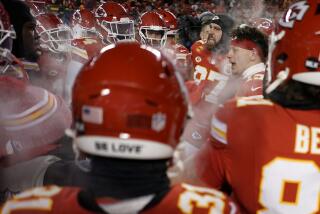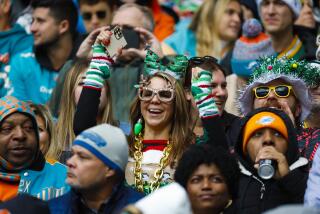A Costly Exhibition
WASHINGTON — The Washington Redskins play host to the NFL season opener tonight with the New York Jets in town, anticipation in the air ...
And Chad Pennington in a cast.
Pennington, quarterback for the Jets, is sidelined because of a broken wrist he suffered in the fourth game of the exhibition season. Meanwhile, in Atlanta, quarterback Michael Vick -- the main reason the Falcons are sold out for only the second time in franchise history -- is recovering from a broken leg he suffered in the second exhibition game. He is expected to sit out at least the first month of the season.
In part because of those high-profile injuries, people inside and outside the NFL are again questioning the length of the preseason. Most teams play four exhibition games -- the equivalent of one-quarter of the regular season -- and some play five, if they’re picked to play overseas or in the Hall of Fame game.
Exhibition games aren’t just hard on the teams. Fans pay full price for tickets, parking and concessions, even though the star players seldom play longer than a half, and sometimes their cameo lasts less than a quarter.
“The last [exhibition] game I saw on television was the Jets playing the [Philadelphia] Eagles, and it was a disgrace,” said CBS analyst Boomer Esiason, a former NFL quarterback. “Both coaches decided no starter was going to play, yet every fan that went to that game paid a full price to watch a glorified NFL Europe game. The injuries are going to happen, regardless, but the fact that these games don’t mean anything -- except more money going one way -- is a disgrace.”
Typically, teams incorporate exhibition games into the cost of season tickets, so holders pay for eight regular-season games and two exhibitions. Some teams use popular regular-season games as leverage to sell more exhibition tickets. For instance, those people who bought single-game tickets to see the Minnesota Vikings play host to the Green Bay Packers also were required to buy a corresponding number of tickets to the Minnesota-Jacksonville exhibition game.
Fan Andrea Britt of Seattle, whose family has owned Seahawk season tickets since the team’s inception in 1976, passed on buying her two 50-yard-line seats this season, partly because the package mandated she pay for two $78 seats to the two exhibition games.
“Most often, we couldn’t even give preseason tickets away,” she said. “The only time we could give them away was the first year of the new stadium. People wanted to see that. Nobody’s heard of the players and most of them won’t be around when the actual season starts.”
Broadcast rights to exhibition games are included in the league’s TV contracts, which will be renegotiated after the 2005 season, and team owners are unlikely to backtrack on what has become a lucrative ramp-up to the regular season. After all, they have to pay veteran players only a $900 per diem for exhibition games, and rookies earn only $725. (NFL players don’t start receiving their salaries until the regular season, when they get weekly paychecks. They are paid a flat fee in training camp depending on experience.) Even so, the NFL Players Assn. says, there is no simple solution.
“It’s not as if the preseason is all negatives and no positives,” said Doug Allen, assistant executive director of the NFLPA. “Fans who don’t normally get to see their team get to see a game. It’s a great vehicle for promoting the sport overseas, and we need a worldwide audience.
“There are a lot of dominoes out there, and when you start knocking them down there are consequences.”
Proponents of the four-game exhibition season say coaches need that time to evaluate talent -- rosters are trimmed from 80 to 53 players during that span -- and work out the kinks in sophisticated offenses and defenses. Opponents argue that college coaches evaluate players and implement game plans in a far more condensed training camp, and those coaches are working with less experienced athletes.
Some people have suggested switching to an 18-game season, essentially making two exhibition games count. But that too is problematic. A longer season increases the likelihood of injuries to key players, and doesn’t make sense for television.
“You would be extending into a lower-rated time of year when advertisers have only modest interest,” said TV consultant Neal Pilson, former president of CBS Sports. “The last two weekends of August are the lowest-rated of the year. You’d have low-rated games, poor pro attendance, and a decided lack of interest.”
The questions linger, the scrutiny intensifies, but there is little chance there will be a significant change to what has become tradition -- a time when the games are fake and the injuries are real.
More to Read
Go beyond the scoreboard
Get the latest on L.A.'s teams in the daily Sports Report newsletter.
You may occasionally receive promotional content from the Los Angeles Times.











